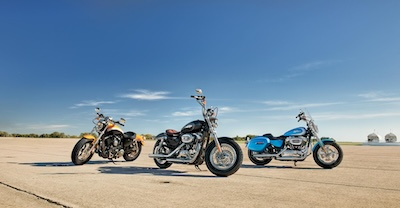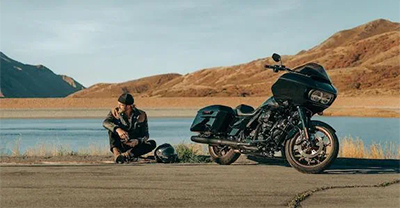Rain, hail, or heatwave—weather isn’t just a riding concern; it could be costing you more than you think. When the skies turn unpredictable, so can your insurance risks and claims. If you've ever wondered why your premiums spike after a storm or why some claims get denied after a rainy-day mishap, you're not alone. In this article, we break down how weather affects motorcycle insurance, what it means for your claims, and how to protect yourself before the next forecast turns nasty.
Weather isn’t just a minor inconvenience for motorcyclists; it’s a real risk factor that can turn a routine ride into an insurance headache. From slippery roads and poor visibility to wind damage and flooding, adverse conditions don’t just affect safety—they shape your insurance claims, too.
In this guide, we’ll break down how weather affects motorcycle insurance coverage, what counts as a Collision vs. Comprehensive claim, and how to prepare both your bike and your policy before the next storm hits.
WEATHERING THE CLAIM: UNDERSTANDING YOUR MOTORCYCLE INSURANCE COVERAGE
When adverse weather leads to damage or an accident, understanding motorcycle insurance coverage becomes critical. It's important to note that the term "full coverage" is not an official insurance term; it typically refers to a policy that combines several types of coverage, including Liability, Collision, and Comprehensive.
While Liability coverage is legally required in most states and covers damages or injuries the rider causes to others, Collision and Comprehensive coverages are the key components that protect the rider's own motorcycle from weather-related incidents.
As a result, the distinction between Collision and Comprehensive is vital for weather-related claims.
Collision vs. Comprehensive Motorcycle Insurance
Damage from a weather event itself (like hail denting the tank) falls under Comprehensive.
Damage resulting from a crash that occurred during bad weather (like sliding on ice into a fence) falls under Collision. Having both coverages provides the broadest protection against the varied ways weather can impact a motorcycle.
Collision Coverage: When Weather is to Blame
Motorcycle Collision coverage helps pay for repairs to the insured motorcycle if it is damaged in a collision with another vehicle or an object, such as a guardrail, tree, or fence. This coverage applies regardless of who is at fault for the collision.
Collision coverage is highly relevant in weather-related scenarios where adverse conditions contribute to an accident. For example:
If a rider loses traction on a rain-slicked road and slides into a curb or guardrail.
If reduced visibility in heavy fog causes a rider to collide with an unseen object.
If strong crosswinds contribute to a loss of control resulting in an incident.
In these situations, Collision coverage would typically respond to cover the repair costs for the motorcycle, minus the policy's deductible. It does not cover medical bills or damage caused to other parties' property; those fall under Liability or other coverages.
The crucial element is that a collision occurred, even if inclement weather was a primary contributing factor.
Comprehensive Coverage: Protection from the Elements (and More)
Motorcycle Comprehensive coverage protects the insured motorcycle against damages resulting from incidents other than a collision. This is the primary coverage that addresses damage caused directly by weather phenomena.
Comprehensive typically covers a range of perils, including:
Weather-Related Issues: Hail damage, damage from falling objects like tree branches during a storm, wind damage (e.g., the bike being blown over while parked), and damage from flooding or rising water. This includes damage that might occur if a rider drives through standing water, potentially causing engine or electrical system failure.
Theft and Vandalism: If the motorcycle is stolen (including from storage) or intentionally damaged.
Fire: Damage caused by fire.
Falling Objects: Damage from objects falling onto the bike (distinct from collision).
Comprehensive coverage generally pays for repairs or replacement up to the motorcycle's Actual Cash Value (ACV), which is the value of the bike just before the damage occurred, accounting for depreciation. The policyholder is responsible for paying the deductible amount out-of-pocket for each claim.
It's important to understand the limitations. Comprehensive coverage typically excludes damage due to normal wear and tear, mechanical breakdowns from lack of maintenance, or gradual damage like rust or corrosion that develops over time, unless it's the direct result of a covered sudden event like a flood.
This exclusion highlights the importance of proper maintenance, especially after riding in wet conditions, as the cumulative effects of moisture leading to rust may not be covered. Additionally, owner-installed electronics or accessories might not be covered unless specifically added to the policy via optional equipment coverage.
Motorcycle Insurance Coverage Snapshot
Coverage Type | What It Generally Covers | Relevance to Weather Incidents | Example Weather Scenario |
Liability | Bodily injury and property damage caused by the rider to others | Pays if the rider is at fault for a mishap in bad weather that harms others or damages their property | Rider slides on wet road and hits another car; Liability covers damage to the other car. |
Collision | Damage to the rider's own motorcycle resulting from a collision with another vehicle or object | Pays if weather conditions (e.g., slick road, poor visibility, wind gusts) contribute to the rider colliding with something | Rider slides on wet pavement into a fence; Collision covers repairs to the motorcycle. |
Comprehensive | Damage to the rider's own motorcycle from non-collision events (theft, fire, vandalism, weather, falling objects) | Pays for damage directly caused by weather elements or events occurring during storms | Hail dents the fuel tank; Comprehensive covers repairs. Bike damaged in a flood. |
FILING A WEATHER-RELATED CLAIM: PROCESS AND POTENTIAL PITFALLS
Experiencing motorcycle damage due to adverse weather conditions can be stressful. Navigating the subsequent insurance claim requires understanding the process and potential challenges, particularly when weather is a contributing factor.
The general claims process involves:
contacting the insurance provider promptly
providing necessary documentation about the incident and damages
allowing an adjuster to inspect the motorcycle
obtaining repair estimates
ultimately, receiving a settlement or payment for repairs (minus the deductible).
Gathering Crucial Evidence
For weather-related claims, comprehensive evidence (including weather-related evidence) is paramount to substantiate the claim and demonstrate the circumstances surrounding the incident. Insurers will need documentation to verify that the damage falls under the policy coverage and to assess any contributing factors.
Key evidence includes:
Photographs and Videos: Capture images of the damaged motorcycle and the scene as soon as it is safe to do so. If possible, document the prevailing weather conditions (e.g., rain intensity, fog density, snow/ice cover, wind damage nearby).
Official Weather Reports: Obtain reports from meteorological services confirming the weather conditions (rain, fog, wind speed/direction, hail, temperature) at the specific time and location of the incident.
Witness Statements: If anyone witnessed the incident or the conditions leading up to it, their contact information and statements can be valuable, especially for corroborating weather severity or events.
Police Reports: If law enforcement responded to the scene, obtain a copy of the accident report.
Road Condition Evidence (for Ice/Snow): If claiming hazardous road conditions due to ice or snow, gather evidence showing the lack of appropriate treatment like salting or sanding, if applicable. Photos taken immediately after the incident can be vital.
Wind Data (for Wind Claims): Official data on wind speeds and direction at the time of the incident can support claims where wind was a major factor.
Navigating Insurer Scrutiny
While Comprehensive claims for direct weather damage (like hail) are often straightforward, Collision claims where weather was a contributing factor may face greater scrutiny. Insurance companies investigate the cause of the accident to determine coverage applicability and potential fault.
Because of this, riders involved in weather-related collision claims must effectively demonstrate not only that the weather conditions were hazardous but also that they acted with reasonable care under those specific circumstances. Simply stating "it was raining" may not suffice. Documenting actions taken to mitigate risk (e.g., reduced speed, use of appropriate gear, condition of tires) can be crucial in countering arguments of negligence.
Understanding the policy before an incident occurs and meticulously documenting everything after are vital steps in navigating potential claim disputes.
READING THE FORECAST: WEATHER PATTERNS, CLIMATE CHANGE, AND INSURANCE COSTS
Motorcycle insurance premiums are influenced by a variety of factors, including:
the rider's age and driving history
the type of motorcycle
the rider's location
Location matters not only due to traffic density and theft rates (urban areas often have higher premiums) but also because of regional climate and prevailing weather patterns. Areas prone to severe weather events like hailstorms, heavy rainfall, or frequent high winds may see higher insurance costs, particularly for Comprehensive coverage, reflecting the increased risk of weather-related damage.
Emerging trends related to climate change are adding another layer of complexity to this risk landscape. As extreme weather events potentially become more frequent and severe globally, insurance providers are grappling with the implications for motorcycle insurance.
HOW TO MINIMIZE RISKS AND PROTECTING YOUR INVESTMENT
While insurance provides a crucial financial safety net, proactive preparation, and skillful riding are the first lines of defense against weather-related hazards. Safety in motorcycling, especially when facing adverse weather, relies on a multi-layered system encompassing the rider's gear, the motorcycle's condition, adaptive riding techniques, sound judgment, and finally, appropriate motorcycle insurance coverage.
Weakness in any of the preventative layers increases reliance on others and elevates overall risk.
Key actions riders can take to minimize risks include:
Gear Up Appropriately: Invest in high-quality riding gear designed for various conditions. High-visibility colors or reflective elements significantly enhance conspicuity in low-light or poor weather conditions.
Maintain Your Machine: Regular pre-ride checks and consistent maintenance are vital. Pay special attention to:
Tires: Check tire pressure frequently (temperature affects pressure) and ensure adequate tread depth for optimal grip, especially on wet surfaces.
Brakes: Ensure brakes are functioning correctly and pads have sufficient life.
Lights: Verify headlights, taillights, and turn signals are working properly for visibility.
Post-Rain Care: Clean and dry the motorcycle after riding in the rain to help prevent rust and corrosion, which may not be covered by insurance if deemed gradual damage.
Adapt Your Riding Techniques: Modify riding style based on conditions. Utilizing situational awareness strategies like SEE (Search, Evaluate, Execute) is crucial in challenging conditions.
Know When to Park It: Check the weather forecast before heading out. If conditions are predicted to be particularly hazardous (heavy rain, dense fog, ice, snow, extremely high winds), consider delaying the trip or choosing alternative transportation.
Review Your Insurance Policy: Periodically review your motorcycle insurance coverage to ensure it aligns with the motorcycle's value and the potential risks associated with your location and riding habits. Pay particular attention to Collision and Comprehensive coverage limits and deductibles. Consider adding optional coverage for custom parts or accessories if applicable. Understanding the policy before an incident occurs facilitates a smoother claims process if needed.
WRAPPING UP
Weather undeniably introduces significant and varied risks for motorcyclists, impacting everything from vehicle control and visibility to the likelihood of encountering specific road hazards.
Navigating these risks involves a dual approach focused on both your physical safety and financial protection. Appropriate insurance coverage, particularly a combination of Collision and Comprehensive policies, serves as a vital financial backstop, addressing damage caused both by weather-related accidents and by the elements themselves.
By staying informed about weather hazards, understanding your insurance implications, and committing to prepared and adaptive riding practices, motorcyclists can continue to enjoy the freedom of the open road while significantly enhancing safety and security, whatever the forecast may hold.
RELATED RESOURCES

Explore the ins and outs of multi-bike insurance, how these policies work, coverages they offer, and benefits they bring to riders with multiple motorcycles.

Considering a switch to a new motorcycle insurance provider? Here’s everything you need to know about evaluating your options and pulling the trigger.

Discover the difference between motorcycle insurance for commuting use vs. pleasure use and how your specific usage might impact your insurance premium.



